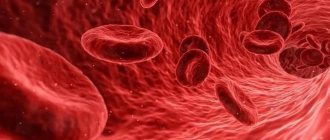Acute leukemia (leukemia) is a malignant oncological disease of the hematopoietic system with primary localization in the bone marrow. Its further spread is observed in the peripheral blood, spleen, lymph nodes and other organs and tissues.
https://repo.knmu.edu.ua/handle/123456789/3190
The incidence of acute leukemia is 13 cases per 100,000 population per year and only 1-2% of all malignant neoplasms annually.
https://repo.knmu.edu.ua/handle/123456789/3190
Acute leukemias are divided into a number of types, among which the most important are acute lymphoblastic (ALL) and myeloblastic (AML) types. Their classification depends on which cells became the initial ones during the development of the disease.
The average age of people who develop acute lymphoblastic leukemia is only 10 years. In the older population, this disease occurs in only 20% of patients.
Lymphoblastic is the most common malignant neoplasm in pediatric practice and accounts for 1/3 of all tumors. It is known that the 5-year survival rate in childhood is 80%, in adults - 40%.
As for acute myeloid, the average age of patients is about 65 years. But unfortunately, every year the incidence increases from 1.8 cases per 100,000 population in children to 17.7 per 100,000 population over 65 years of age. In acute myeloid leukemia, the 5-year survival rate in persons under 20 years of age is 50%, in persons over 60 years of age it is less than 20%.
https://repo.knmu.edu.ua/handle/123456789/3190
Causes of development of acute leukemia
Epidemiological studies of acute leukemia have examined many possible causes that could lead to this disease. But only a single environmental factor (ionizing radiation) is significantly associated with acute leukemia. The degree of risk depends on the radiation dose, duration and age of the person at the time of exposure. The study demonstrated a relationship between the degree of radiation exposure and the occurrence of leukemia. Potential exposure to ionizing radiation in children may occur before conception, during pregnancy, or during the postpartum period.
https://ehp.niehs.nih.gov/doi/full/10.1289/ehp.9023
Most environmental risk factors were found to be inconsistently associated with any form of acute leukemia.
Thus, in addition to ionizing radiation, these include:
- genetic predisposition;
- unfavorable environmental factors;
- significant amounts of carcinogens in everyday life (in particular pesticides, benzene)
- medications (for example, chlorambucil, cyclophosphamide, etc.);
- use of alcohol and illicit drugs;
- smoking cigarettes;
- other hematological diseases.
Also, scientists do not exclude the possibility of infectious risk factors (Epstein-Barr virus, HTLV Retrovirus), maternal reproductive history, pregnancy, genetic defects and chromosomal abnormalities.
https://ehp.niehs.nih.gov/doi/full/10.1289/ehp.9023
How does acute myeloid leukemia develop?
Acute myeloid leukemia (AML) begins in the bone marrow, the soft inner part of the bones made up of fat and blood-forming cells, including stem cells, which become:
- lymphocytes, whose main task is to fight infections and tissue damage;
- or myeloid cells, which can turn into: white and red blood cells that carry oxygen from the lungs to other tissues, as well as platelets, which are necessary to stop bleeding - they help close holes in the vessels that occur with cuts or bruises.
Leukemia begins with a change in DNA, a molecule contained in every cell of our body in which all information about the body is encrypted. Such “breakdowns” occur due to exposure to chemicals, radiation, various diseases or random failures, and lead to the production of too many blasts - rapidly growing immature, that is, non-functioning white blood cells.
Normal blasts eventually turn into useful blood cells, but in leukemia they become tumorous, actively multiply and gradually replace normal ones, which leads to a number of serious consequences. In a healthy person there are not many of them - they make up 5% or less of the bone marrow, and are not found in the blood. In order for a doctor to diagnose “acute myeloid leukemia”, there must be at least 20%.
Such cells do not just circulate throughout the body - they spread to, accumulate and damage various organs, including lymph nodes, liver, spleen, testicles, brain and spinal cord.
Doctors distinguish two main forms of myeloid leukemia: - acute - developing suddenly and quickly; - and chronic - with this type of disease, blasts displace healthy blood cells much more slowly than with acute disease.
Life expectancy with cancer
Life expectancy is determined for an individual patient or group of patients; it is either the exact or average period that the patient managed to live from the starting point of diagnosis or completion of some special treatment. In addition to the oncological process itself, the life expectancy indicator is influenced by age, gender, physical condition and concomitant diseases, as well as genetics and previous lifestyle, anti-cancer therapy, that is, individual variables. It is possible to transpose the standard life expectancy indicator to a specific person with very large reservations.
Is it possible to rely on the life spans indicated in the results of clinical trials of methods and drugs? It is imperative to take into account that at the end of clinical trials, the process of monitoring patients often ends, funding has ended and the participants “go about their business”, and to evaluate the result of the experiment they resort to a mathematical calculation of expected survival. It is clear that the estimated life expectancy of patients derived by statisticians will not always reflect reality.
Causes of acute myeloid leukemia
Doctors still do not know the exact reasons for the development of this disease - they only know about the factors that can trigger its occurrence:
- Age
: Acute myeloid leukemia occurs in both children and adults, but it is most often found in older people, and the average age of diagnosis is about 68 years. - Smoking
is the only proven lifestyle risk factor. A bad habit can cause not only cancer of the lungs, mouth or throat, since toxic smoke also affects cells that do not come into direct contact with it. The substances it contains are absorbed by the respiratory tract and distributed through the blood to various parts of the body, including the bone marrow. - Chemicals
: Long-term exposure to benzene, a solvent used in the rubber and automobile industries and oil refineries, has been linked to the development of leukemia. It is found in gasoline, cigarette smoke, car exhaust, some adhesives, cleaning products and paints. - Radiation
: Radiation exposure, including that received from radiation therapy for cancer, increases the likelihood of AML. - Blood diseases
are also considered risk factors that can provoke acute myeloid leukemia. - Gender
: Adult men are diagnosed more often than women, while among young patients there are approximately as many boys as girls. The reasons for such statistics are still unknown to scientists. - Genetic disorders
. The chance of developing AML is increased in those with various genetic disorders and characteristics, including Down syndrome Down syndrome is a genetic disorder that causes mental retardation, developmental delays, heart defects and a variety of other health problems. People with this developmental feature do not have 46 chromosomes, but one more - 47. and trisomy 8 Trisomy 8 is a genetic developmental disorder, the owners of which have not two copies of the eighth chromosome, but three. . - Treatment
: The disease is more likely to develop in cancer patients who are receiving certain chemotherapy drugs. These include cyclophosphamide, mechlorethamine, procarbazine, chlorambucil, melphalan, busulfan, carmustine, cisplatin, carboplatin, etoposide, teniposide, mitoxantrone, epirubicin and doxorubicin. - Family history
: Having a close relative - a parent, brother, sister or children - with this diagnosis increases the risk of developing this disease.
Life expectancy depending on the stage of cancer
Oncology statistics use the percentage of patients who survived a certain period of time after cancer diagnosis without recurrence of the disease - one year, 3 years, 5 and 10 years. This is more convenient, but not more reliable, because survival also depends on the stage, gender, age, concomitant diseases and sensitivity of the malignant tumor to therapy.
It is known that with early cancer, 85-95% will survive 5 years without recurrence of the disease; only with lip cancer, out of hundreds of those treated, 70 will survive more than five years, with melanoma - 97, and with squamous cell skin cancer, all 100.
What do these numbers say? Only that lip cancer is more aggressive than other malignant tumors, and its modern treatment cannot be considered effective and efforts must be made to develop new therapeutic approaches.
For stage 2A breast cancer, 93% survive five years. The prognosis for life with a tumor of 5 centimeters without axillary metastases will be more favorable than with a cancerous node of 2.5 cm with damage to the axillary lymph node. With the same prevalence, life prospects are similar if all other criteria are the same: age, menstrual function, histology, receptor status, tumor genes and concomitant diseases. If at least one characteristic differs, the average survival rate is parallel to objective reality and it is completely useless to predict the prospects for life.
Symptoms of acute myeloid leukemia
Signs of leukemia appear approximately the same in both children and adults, and may look like this:
- Typically, one of the first symptoms is excessive fatigue and weakness
. They occur due to anemia - a decrease in the number of red blood cells that carry oxygen to all tissues of the body. - Dizziness
is another frequent companion of the disease. The most likely reason for their appearance is the same anemia, due to which the brain lacks O2. - Sudden weight loss
: As a rule, people lose weight already in the early stages of the disease, including due to decreased appetite. - Bruising or bleeding
: As acute myeloid leukemia progresses, the bone marrow produces fewer platelets, the cells responsible for blood clotting. When there are too few of them, a person bruises easily and has red or purple spots on the skin, blood comes from the nose and gums, traces of it are found in urine or stool, and menstruation becomes heavier. - Fever
at any time of the day and night sweats: often caused by infections that develop when the hematopoietic system is disrupted. - Pale or cold skin
, as well as sensitivity to cold temperatures, caused by anemia. - Bleeding, pain and swelling of the gums
: may be a sign of thrombocytopenia - a lack of platelets necessary for proper blood clotting. - Shortness of breath
is a feeling of lack of air: in the early stages of leukemia it is usually caused by a lack of oxygen-carrying cells, and in the later stages it can be caused by thromboembolism - blockage of the pulmonary artery. This serious complication causes a range of symptoms, such as pain in the chest, neck, shoulders, arms and jaw, anxiety and restlessness, arrhythmia - irregular heartbeat rhythm, tachycardia - too fast heartbeat, and fainting. - Frequent infections
are another sign of the disease, which appears due to the presence of a large number of altered white blood cells in the body. Their excess leads to a lack of normal neutrophils - cells that fight bacteria and fungi. - Leukostasis
: accumulation of altered cells in the vessels, which leads to stroke-like appearance. Stroke is a violation of blood circulation in the brain. symptoms: drowsiness, headaches, facial numbness, shortness of breath, visual disturbances, weakness and even speech problems. - Bloating
: Not the most common problem for people with acute myeloid leukemia. It occurs when abnormal cells accumulate in the spleen and liver, leading to poor digestion. - Rash or lumps
: Occurs in approximately 10% of patients. Their presence may indicate the spread of the disease to the skin. - Another possible symptom is pain in the joints and bones
due to the presence of a large number of altered cells in them. - Headaches
can be a sign of both anemia and brain damage. - Enlargement of lymph nodes
- our tiny “filters” that retain and neutralize dangerous substances. They often feel like small, pea-sized lumps under the skin in the neck, armpits, or groin.
Symptoms of leukemia
For blood cancer, the symptoms are as follows:
- weakness and increased fatigue;
- dizziness;
- pallor;
- bleeding and hemorrhage;
- temperature increase;
- bone pain;
- nausea and vomiting;
- loss of appetite and body weight.
Lymphatic cords enlarge and immunity decreases. After a short time, metastases develop, signs of damage to the liver, spleen, lungs, etc. appear. The acute form develops quickly, the chronic form develops over several years.
Our expert in this field:
Moiseev Alexey Andreevich
Oncologist, Ph.D.
Candidate of Medical Sciences
Experience: More than 19 years
Call the doctor
Call the doctor
Diagnosis of acute myeloid leukemia
A thorough diagnosis is extremely important, since during its course the doctor can not only establish the very fact of the presence of the disease, but also understand which treatment is suitable for a particular patient.
Diagnosis begins with a routine physical examination and search for bruises, bruises or possible signs of infection, after which a number of procedures are prescribed:
- Blood tests
: allow you to see its composition, detect changed cells, and also evaluate the functioning of internal organs such as the liver or kidneys. - Collecting bone marrow samples
: this procedure is mandatory because this is where the disease begins to develop. Typically, samples are taken from the back of the pelvis or chest bones in two painful, simultaneous procedures. During aspiration, the patient lies on his side or stomach, the doctor cleans the skin of the thigh, numbs the tissue and inserts a thin needle into it, after which a small amount of liquid bone marrow is sucked out with a syringe. During a biopsy, the specialist also removes small pieces of bone using a thicker needle. - Cerebrospinal fluid test
- lumbar or spinal tap: ordered if a person has symptoms that may be caused by the spread of abnormal cells into the brain or spinal cord. To collect samples, the doctor numbs an area of skin in the lower back above the spine and inserts a small needle into the area between the vertebrae. - Molecular and genetic tests: needed to detect mutations, or changes, in genes. Doctors need such data to select the optimal treatment.
- Imaging tests - ultrasound, X-ray, MRI or PET scan: create images of the internal tissues of the body. They are not prescribed to detect leukemia per se, but to detect infections, other health problems, or determine how advanced the disease is if experts believe it has spread beyond the bone marrow.
Department of Oncohematology, Cancer Center Lapino-2.
Treatment of acute myeloid leukemia
The fight against leukemia is a complex task and requires the participation of several doctors at once - not only a hematologist, but also an oncologist, a chemotherapist and others.
Onco has a whole team of excellent specialists who will not only quickly identify the disease, but also carry out any necessary treatment procedures. You don't have to wonder "what to do?" and “who should I contact?” – with us you will receive a clear action plan, following which you will undergo therapy without queues, delays and nerves.
Doctors use several methods to treat myeloid leukemia.
- Chemotherapy
– destruction of altered cells with special drugs. Such substances are administered through IVs or taken in tablet form, enter the bloodstream and spread throughout the body.For most patients it consists of two stages:
- Induction of remission
: the first phase, the task of which is to quickly reduce as many leukemia cells as possible. During this procedure, the person is usually in a medical facility, since the drugs destroy not only abnormal but also normal bone marrow cells. As a result of this effect on the body, blood counts become dangerously low, causing the patient’s well-being to deteriorate. Many people must take antibiotics and drugs that increase white blood cell counts, and some require blood transfusions. About a week after the end of chemotherapy, the doctor performs a biopsy and examines the condition of the removed tissue. Most patients experience remission after the first course - blasts Blastes are rapidly growing immature, non-functioning white blood cells. constitute no more than 5% of the total bone marrow volume. If tests reveal an excess of them, the person is prescribed re-treatment, or a stem cell transplant is recommended. Stem cells produced by the bone marrow can become: red blood cells that carry oxygen throughout the body; white blood cells that help fight infections; and platelets, which stop bleeding.) During the induction stage, it is usually not possible to kill all blasts - a small part of them still remains in the body. In this case, therapy must be continued, otherwise the disease may return within several months.
Consolidation
is the second phase, prescribed to completely destroy the changed cells and prevent relapse - re-development of leukemia. Its regimen is selected individually for each patient - it depends not only on the general health of the person, but also on his age.
– bone marrow transplant, the cells of which can become red blood cells that carry oxygen throughout the body; white blood cells that help fight infections; and platelets, which stop bleeding.
This procedure is suitable for patients who cannot tolerate the side effects of chemotherapy. High doses of these drugs work well, but they are not prescribed to everyone because they seriously damage the bone marrow. If the standard treatment regimen does not work, doctors use:
- allogeneic
transplantation of cells from a suitable donor - a close relative such as a brother or sister, or another volunteer;
or transplantation of autologous
– a person’s own stem cells, removed and frozen before the start of the course of “chemistry”.
– taking special drugs that work only against certain substances in altered cells. Today there are several types of such drugs:
- some block proteins that help abnormal cells grow;
Such drugs are prescribed both independently and in combination with chemotherapy, but they do not help all patients - they only work against certain mutations.
Killing the damaged cells with radiation is not part of the main treatment for myeloid leukemia. This method is used in several cases:
- when the disease spreads beyond the bone marrow and blood: for example, into the brain, cerebrospinal fluid or testicles;
Types of leukemia
More than half of all cases are acute leukemia of various forms, characterized by an aggressive increase in the number of poorly differentiated blast (immature) cells.
Chronic leukemia develops slowly, over several years, is found mainly in people over 40 years of age; in childhood, adolescence and adulthood, the development of the disease has its own characteristics.
In blood cancer, the stages differ from the gradation traditional for most malignant tumors, since cancer cells in this case immediately spread through the circulatory system throughout the body. However, during the development of the disease, the following stages are distinguished:
- initial - asymptomatic;
- expanded - symptoms of impaired hematopoietic processes appear;
- remission, complete or incomplete, when symptoms disappear or become less pronounced;
- relapse - the influence of malignant processes manifests itself again;
- terminal stage - the functioning of all important organs is disrupted, cure is almost impossible.
Send documents by email The possibility of treatment will be reviewed by the chief physician of the clinic.
Hospitalization of cancer patients. Daily. Around the clock
9,500 patients trust us annually.
Call me back!
Acute myeloid leukemia status after treatment
The long-term prognosis of each patient largely depends on how well and quickly the disease responds to treatment: the better the body’s first reaction, the more optimistic the prospects.
Remission - no signs of leukemia: the bone marrow contains less than 5% blasts. Blasts are rapidly growing immature, non-functioning white blood cells. , and the number of blood cells is within normal limits. Complete molecular remission means that doctors were unable to detect the altered cells even with very sensitive tests.
Minimal residual disease , MRD: This term is used when, after treatment, abnormal cells are not detected by conventional methods - for example, by standard examination of samples under a microscope, but are detected by modern accurate examinations.
Active disease: after treatment there are more than 5% blasts in the bone marrow, or after therapy a relapse occurred - the disease returned.
Treatment methods for blood cancer
Therapy is carried out in a specialized clinic or hematology hospital. The main and most effective method of treating blood cancer is chemotherapy aimed at eradicating cancer (blast) cells. The process of treating leukemia requires several stages. These include induction, consolidation and maintenance therapy, according to specially developed treatment protocols.
In addition to chemotherapy, patients are prescribed transfusions of blood components (erythrocytes, platelets), antibiotics, and immunotherapy drugs according to indications. An effective method for preventing relapses of the disease is hematopoietic stem cell transplantation, which in some cases can completely cure blood cancer.










